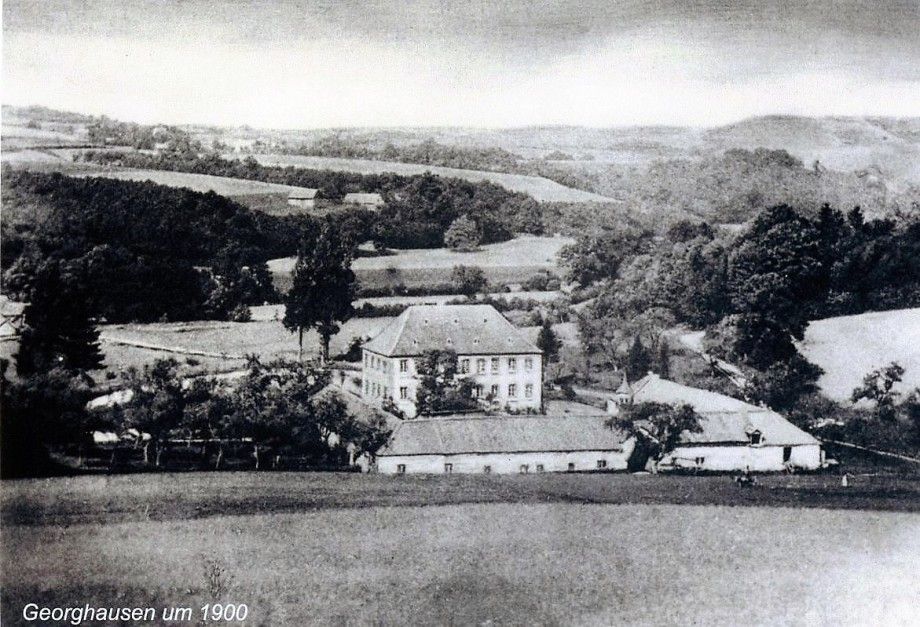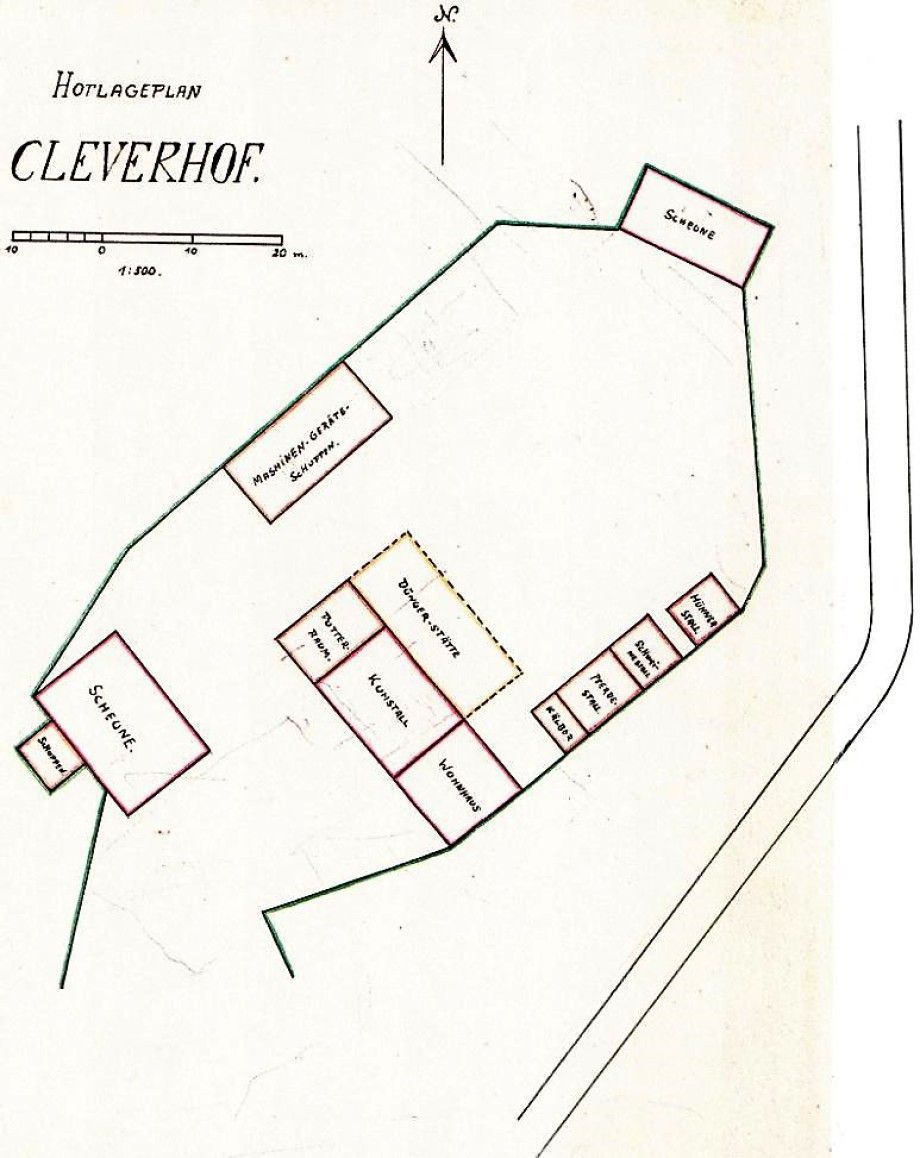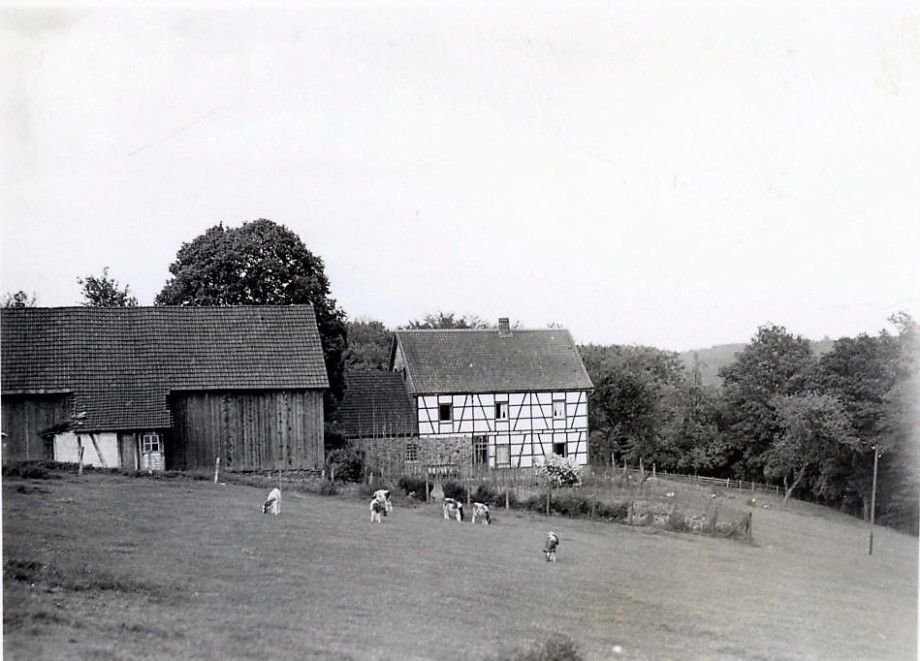Cleverhof Offermannsheide
Hans Reck
Version from September 2022
Historical maps for the Steinbach district show that the village already existed in 1715 and was named Freihof n. Clef was named there. A map from 1789 shows that Cleverhof was part of the Hohnschaft Engeldorf. Under French administration between 1806 and 1813, the Steinbach office was dissolved and Cleverhof became part of the Mairie Kürten. From 1816, under Prussian administration, Cleverhof belonged to the mayor's office and later to the municipality of Kürten. In a map from 1824, the farm is recorded as Kleverhof or Cleverhof, in a map from 1830 as Hof Clev. In dialect, the estate is called "Cliverhoff", which could mean farm on a slope.
The manor house, built in the Bergisch half-timbered style, is on the left-hand side. The ceiling height of three meters is unusual for Bergisch half-timbered houses. The former stables are located on the right-hand side. The stables on the left-hand side are even older than the residential building.
On Corpus Christi Day on June 19, 1930, the procession went from Offermannsheide to Cleverhof and back. During the procession, a barn in Cleverhof went up in flames. All the hay stocks were lost. During the last world war, the estate was the target of an air raid on January 18, 1945. A barn on the west side of the estate burned down completely. The stable building and the barn were damaged and 30 head of cattle were lost. Immediately after the bombing, the stable building was repaired and raised to the ridge height of the residential building. The barn was not rebuilt. Another fire in a barn or stable building, which was located on the right-hand side in the entrance area of the estate, occurred in the second half of the 1950s. Here too, livestock and the hay harvest were affected.
The estate has been owned by the family since 1820 and is now managed by Roswitha and Dietmar von Landsberg. In the past, the estate was used to supply the inhabitants of Georghausen Castle. From the early 20th century until 1961, it was leased to various farmers.
n June 19, 1902, the estate finally became the property of Baroness von Fürstenberg-Heiligenhoven, later Baroness von Landsberg, in Georghausen for the purchase price of 20,500 marks. The Bosbach family moved to Biesfeld and Wilhelm Breidenbach leased the house from the von Landsberg family. Since then, the house with the restaurant sign (see below) "Gasthaus zur Sülze" was also popularly known as "Gasthaus Breidenbach".
After the death of innkeeper Wilhelm Breidenbach on September 12, 1918, his widow Anna continued to run the inn with her unmarried sons Rudolf (sexton, organist and choirmaster since 1934) and finally Viktor until her death in 1960.
As a village inn, it was mainly used by churchgoers for the Sunday morning pint and by local clubs for meetings and rehearsals, as well as by locals for their evening get-togethers over a schnapps or beer. As was often the case with landlords, farming continued as an additional source of income.
With the land register entry of March 26, 1968, the building with 1000 square meters of land was acquired by the married couple Wilhelm and Agatha Wurth, Welzen, from Zita Freifrau von Fürstenberg, née Freiin von Landsberg. Since then, the building has been used exclusively for residential purposes.
The economic situation in the 30s
Besides the historical description of the estate, it is very interesting to see what the economic situation was like in the 1930s. Emanuel Freiherr von Landsberg reported on the economic concerns of the estate in 1933/34, according to which the cultivated area amounted to 41.83 ha, of which approx. 44% was arable and garden land, approx. 23% meadows and approx. 32% pastures. The high proportion of arable land was predominantly wheat and rye, with far fewer oats, barley, rye and potatoes. There were a total of 30 head of cattle, including 12 cows. Three farm horses (Rhenish-Belgian cold-blooded) were used for farm work. The tenant of the estate employed two workers. Day laborers were brought in to help out during peak work periods, e.g. 12 workers during the potato harvest.
Sources:
Description in Wikipedia "Cleverhof" September 2021,
Personal information: Roswitha and Dietmar von Landsberg
Maria Louise Denst: Lank on Lück an U'epe, Söulze on drömeröm, Paffrath Verlag Kürten,
Theo Stockberg: Gewässer-, Flur- und Ortsnamen in der Gemeinde Kürten und deren Umgebung-Abteilung III Ortsnamen, Kürtener Schriften, Heft 3, November 2001, publisher: Geschichtsverein für die Gemeinde Kürten und Umgebung e.V.
Hermann Engeländer: Offermannsheide, Eine Dorfchronik, Volume 2, published as a manuscript, November 1982,
Emanuel Freiherr von Landsberg: Wirtschaftsbeschreibung des Bauernhofes Cleverhof, lecture at the Höhere Lehranstalt für praktische Landwirte zu Potsdam, winter semester 1933/34.





